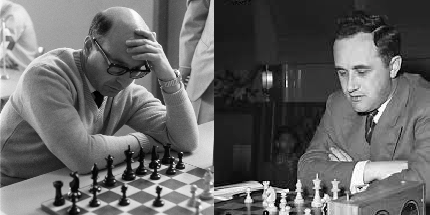
Nikolaevsky, Geller and Bronstein- 2 games, One Over-Arching Theme
Players, ideas and moves coincide in unexpected ways. Success and failure, fame and anonymity are the workings of Fate. As Simaginfan has pointed out in his posts, many great players remain virtually unknown in the future.
Because of my interest in chess, I have, by default, become interested in great players from the Soviet Union. After its foundation in 1922, the Soviet Union started a process of popularizing chess.
Chess became, in the eyes of the Soviet authorities, an important activity. Accomplishment in chess could mean an escape from stark poverty, although not riches!
On that note, there is a famous story about a game between Bronstein and Smyslov....after 12 moves, the players agreed to a draw. Maybe it was this game:
The chief arbiter protested: " A draw? There is still a lot of fight in this position. you must play! The State pays you to play!" To which Bronstein responded in an immortal way: "You want me to attack Smyslov, FOR 3 RUBLES A DAY?"
----------------------------------------------------------------------------------------------
The rise of importance of chess in the Soviet Union led to the establishment of a structure designed to locate and cultivate chess talent. The Palace of Pioneers Clubs were places where children could get instructions in a variety of subjects, including chess. If a child was talented, he would be assigned a coach, and as the child progressed, the coaches could be upgraded too, to meet the needs of the player.
This resulted in the development of great chess talents, and when I started studying chess in 1972 (at the time of the Spassky-Fischer match), I became acquainted with some of the Grandmasters of that era, specifically from Alekhine all the way to Spassky and Fischer.
But here is a point, a poignant point! Not all Masters were fortunate in the Soviet Union. Both Alekhine and Keres were accused of plotting against the Soviet State, and were to be executed, but others intervened and saved their lives. Some Masters lost their lives that way; they did not have anyone to intercede for them!
In the following video, after 2:11, you can hear and see how some chess Masters met this unfortunate fate:
Thanks to Batgirl, we have an image of Yuri Nikolaevsky:
 Yuri Nikolaevsky (1937-2004)
Yuri Nikolaevsky (1937-2004)
Where am I going with this? Well, a few weeks ago I posted an article about the move Bb5, and how it presented itself in different circumstances. Well, I believe I forgot one example, which is a very creative one! It is the game Bronstein-Nikolaevsky, from the 34th USSR Championship. I found it in the book "The Sorcerer's Apprentice", one of the best chess books ever written, in my opinion!

In the game, Bronstein plays the Rubinstein idea...Bb5!, to dominate the queeenside!
Then, casually reading the great book "The Nemesis: Geller's Greatest Games" (Quality Chess, 2019), I found a game, Geller-Nikolaevsky, where both Black and White sacrificed the Queen!

And then, in another coincidence, today I find out, both games were played in the same tournament!
I have included here some of Geller's comments; they are most instructive.
By the way, Nikolaevsky was a strong Master! Just take a look at this win, with Black, against Gufeld!
Thanks to Simaginfan, wee can offer two variations in the above game: